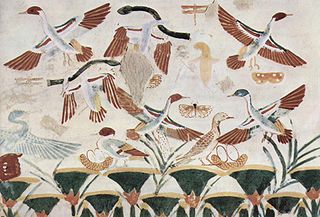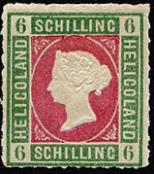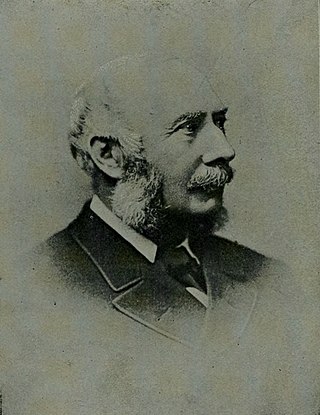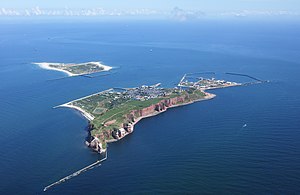
Heligoland is a small archipelago in the North Sea. A part of the German state of Schleswig-Holstein since 1890, the islands were historically possessions of Denmark, then became the possessions of the United Kingdom from 1807 to 1890, and briefly managed as a war prize from 1945 to 1952.

Bird ringing (UK) or bird banding (US) is the attachment of a small, individually numbered metal or plastic tag to the leg or wing of a wild bird to enable individual identification. This helps in keeping track of the movements of the bird and its life history. It is common to take measurements and examine the conditions of feather moult, subcutaneous fat, age indications and sex during capture for ringing. The subsequent recapture, recovery, or observation of the bird can provide information on migration, longevity, mortality, population, territoriality, feeding behaviour, and other aspects that are studied by ornithologists. Other methods of marking birds may also be used to allow for field based identification that does not require capture.

A Heligoland trap is a large, building-sized, funnel-shaped, rigid structure of wire mesh or netting used to trap birds, so that they can be banded or otherwise studied by ornithologists.

The following is a timeline of ornithology events:

Henry Seebohm was an English steel manufacturer, and amateur ornithologist, oologist and traveller.

A bird observatory is a centre for the study of bird migration and bird populations. They are usually focused on local birds, but may also include interest in far-flung areas. Most bird observatories are small operations with a limited staff, many volunteers and a not-for-profit educational status. Many bird observatories conduct bird ringing or bird banding.

The Battle of Heligoland was fought on 9 May 1864, during the Second Schleswig War, between a Danish squadron led by Commodore Edouard Suenson and a joint Austro-Prussian squadron commanded by the Austrian Commodore Wilhelm von Tegetthoff. The action came about as a result of the Danish blockade of German ports in the North Sea; the Austrians had sent two steam frigates, SMS Schwarzenberg and Radetzky, to reinforce the small Prussian Navy to help break the blockade. After arriving in the North Sea, Tegetthoff joined a Prussian aviso and a pair of gunboats. To oppose him, Suenson had available the steam frigates Niels Juel and Jylland and the corvette Hejmdal.

The Alfred Wegener Institute, Helmholtz Centre for Polar and Marine Research is located in Bremerhaven, Germany, and a member of the Helmholtz Association of German Research Centres. It conducts research in the Arctic, the Antarctic, and the high and mid latitude oceans. Additional research topics are: North Sea research, marine biological monitoring, and technical marine developments. The institute was founded in 1980 and is named after meteorologist, climatologist, and geologist Alfred Wegener.

Henry Eeles Dresser was an English businessman and ornithologist.
Heligoland is a German island in the North Sea.

During the period when Heligoland was a British possession, about 20 postage stamps were issued between 1867 and 1890. There were up to eight printings of a single denomination and also a large volume of reprints which are known as the Berlin, Leipzig and Hamburg Reprints, respectively. The Berlin reprints are sometimes better quality than the originals. The reprints were done between 1875 and 1895. Consequently, many "old" collections contain reprints rather than originals. Some believe there were seven million reprints as compared to the known 1½ million originals, of which perhaps half were sold through the post office and the remainder sold to dealers when withdrawn from use. A few printings were never postally sold but nevertheless found their way into the hands of dealers. The stamps were printed by the Prussian State Printing Office in Berlin. They were denominated in the Hamburg Schilling until 1875, when both German Reich and British values appeared on each stamp issue. All are embossed with a silhouette of Queen Victoria excepting the four highest values which represent Heligoland escutcheons.

Heinrich Gätke was a German ornithologist and artist.
George Waterston OBE FRSE FZS LLD was a 20th-century Scottish stationer, ornithologist and conservationist. From 1949 to 1954 he owned the remote Scottish island, Fair Isle.

Max Hugo Weigold was a German zoologist and a pioneer bird bander who worked at the Heligoland Bird Observatory, one of the world's first bird-ringing sites.

The Rossitten Bird Observatory was the world's first ornithological observatory. It was sited at Rossitten, East Prussia, on the Curonian Spit on the south-eastern coast of the Baltic Sea. It was established by German ornithologist Johannes Thienemann and operated until 1944. In 1945 East Prussia was divided between Poland, Russia and Lithuania, and most ethnic Germans expelled.

The Swiss Ornithological Institute is a non-profit foundation headquartered in Sempach in the district of Sursee in the canton of Lucerne in Switzerland dedicated to the study and conservation of birds.

John Cordeaux, MBOU was one of the foremost English amateur naturalist and ornithologist of his day, known for his work with the British Association on bird migration.

The Mongolian Ornithological Society), was founded in 1999 in the capital city, Ulaanbaatar. It is non-profit environmental organisation dedicated to the research and conservation of birds and their habitats, and also other wildlife in Mongolia. It publishes a peer-reviewed annual scientific journal, Ornis Mongolica, and other bird-related books, guidebooks and papers on bird research works and conservation activities in Mongolia and other countries. The Society raises funds for conservation and educational activities by arranging bird watching and wildlife tours to different parts of Mongolia. The society puts great emphasis on educating young researchers and raising public awareness on conservation. Its board members consist of well-known ornithologists, biologists and ecologists from Mongolia and other countries. In collaboration with the Ornithological Laboratory at the National University of Mongolia, a total of more than 30 scientific theses by bachelors, masters, and Ph.D. students have been supervised by members of the society.
Rudolf Karl Theodor Drost was a German ornithologist best known for his studies on bird migration conducted at the Heligoland observatory.



















